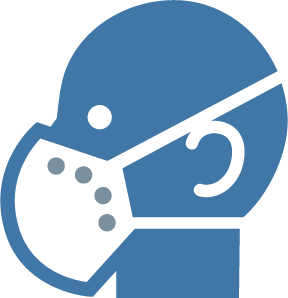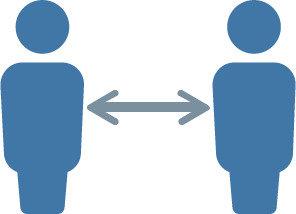Tips on Mask Wearing
 There is a lot of confusion around wearing a mask given the recent changing guidelines,
anxiety for some people about covering your nose and mouth, and misinformation. The
Center for Disease Control and Prevention (CDC) and the World Health Organization
(WHO) have updated their guidelines to recommend the general public wear masks in
public places when they expect to be within 6 feet of one another. These updates are
based on more research and better understanding of the specific disease transmission
of COVID-19[1]. Masks have been found to protect healthy persons and reduce disease transmission
among those who are asymptomatic. Masks are effective in reducing disease transmission
and mortality, particularly when they are combined with other practices, such as frequent
handwashing and social distancing[2].
There is a lot of confusion around wearing a mask given the recent changing guidelines,
anxiety for some people about covering your nose and mouth, and misinformation. The
Center for Disease Control and Prevention (CDC) and the World Health Organization
(WHO) have updated their guidelines to recommend the general public wear masks in
public places when they expect to be within 6 feet of one another. These updates are
based on more research and better understanding of the specific disease transmission
of COVID-19[1]. Masks have been found to protect healthy persons and reduce disease transmission
among those who are asymptomatic. Masks are effective in reducing disease transmission
and mortality, particularly when they are combined with other practices, such as frequent
handwashing and social distancing[2].
 It can be anxiety provoking to wear a covering across your nose and mouth. During
times of stress our brain can be on “high alert” looking for any signs of potential
danger. While this is adaptive at times, our brain may interpret normal signals as
dangerous when, in fact, these signals are ordinary variations in heart rate or breathing.
For example, it is normal for your heart rate to fluctuate during the day. In times
of stress, these normal fluctuations may be interpreted as a signal to prepare your
body to “fight, flight, or freeze”. This misinterpretation can form a feedback loop
increasing anxiety or sense of danger. Think about an overly sensitive car alarm.
Whenever anyone walks past, the car alarm goes off– honking loudly to signal a break-in–when
in fact, someone was just walking nearby. If the car alarm is triggered by everything,
there is no ability to distinguish between a true break-in and someone just walking
by. This can happen with our “fight, flight, or freeze” system. We can perceive potential
danger, when in fact, there is no actual danger in our environment.
It can be anxiety provoking to wear a covering across your nose and mouth. During
times of stress our brain can be on “high alert” looking for any signs of potential
danger. While this is adaptive at times, our brain may interpret normal signals as
dangerous when, in fact, these signals are ordinary variations in heart rate or breathing.
For example, it is normal for your heart rate to fluctuate during the day. In times
of stress, these normal fluctuations may be interpreted as a signal to prepare your
body to “fight, flight, or freeze”. This misinterpretation can form a feedback loop
increasing anxiety or sense of danger. Think about an overly sensitive car alarm.
Whenever anyone walks past, the car alarm goes off– honking loudly to signal a break-in–when
in fact, someone was just walking nearby. If the car alarm is triggered by everything,
there is no ability to distinguish between a true break-in and someone just walking
by. This can happen with our “fight, flight, or freeze” system. We can perceive potential
danger, when in fact, there is no actual danger in our environment.
 In order to cope with the anxiety around mask-wearing, we need to retrain our “fight,
flight, or freeze” system to respond to actual, rather than perceived, danger. We
recalibrate the system through what is referred to as systematic deconditioning or
prolonged exposure. Your anxiety will decrease naturally, while gaining comfort with
and gradually increasing your contact with the mask.
In order to cope with the anxiety around mask-wearing, we need to retrain our “fight,
flight, or freeze” system to respond to actual, rather than perceived, danger. We
recalibrate the system through what is referred to as systematic deconditioning or
prolonged exposure. Your anxiety will decrease naturally, while gaining comfort with
and gradually increasing your contact with the mask.
Guidelines for getting used to your mask:
If mask-wearing is giving you anxiety or activating stress, here are some tips for getting used to your mask:
- Practice these exercises between 45 minutes to 1 hour a day. The time can vary, but the important part is to continue with the activity until your anxiety has fallen to a manageable level.
- Monitor your anxiety levels using a 1 to 10 scale with 1 being the lowest anxiety and 10 being the highest.
- When your anxiety is at a manageable level, or consistently below a 4 by the end of each exercise, for a couple days in a row, it is time to try the next step. Remember, it is important for you to go at your own pace.
- Breathing exercises can help. Breathing in for 4 counts, then breathe out for 6 counts. Breathe deep to ensure you engage your diaphragm.
- In a safe, comfortable space, practice holding your mask. Be sure to monitor your anxiety levels. Pay attention to your thoughts. What thoughts are increasing your anxiety? Try to focus on being present. For example, ask yourself, what does the fabric feel like? What are the colors? The breathing exercise mentioned above can also assist with coping.
- When your anxiety is consistently below 4, you are ready to try holding the mask up to your face. Again, monitor your anxiety levels and pay attention to your thoughts. Try to stay present and breathe.
- Move on to step 3 when you have mastered holding the mask up to your face with manageable levels of anxiety. Now put the straps over your ears or behind your head. Continue to monitor your anxiety level and practice breathing exercises.
- When you’re ready, practice walking around the room or your home while wearing the mask. Continue to monitor your anxiety level and practice breathing exercises.
- The next step is to gaining comfort wearing the mask while talking to people. Start by talking with people you already know very well and are comfortable with. Again, continue to monitor your anxiety level and practice breathing exercises. When your anxiety is consistently below a 4, you’re ready to move on to the last step.
- Finally, you’re ready to take mask wearing outside to a new environment. Consider taking a walk in your neighborhood, a quick trip to the nearby gas station or pharmacy. Continue to practice breathing exercises. When you are ready, anxiety is consistently below a 4, wear your mask out for longer periods of time, such as grocery shopping. Slowly, over time, you will feel more comfortable in a variety of places and the anxiety will continue to go down.
Who should not wear a mask:
- Children under 2.
- Those who have difficulty tolerating a mask due to sensory issues. For example, children with sensory processing disorders or autism.
- Those experiencing an acute exacerbation of a pre-existing chronic pulmonary illness. People with a chronic pulmonary illness are at a higher risk for severe disease and complications from COVID-19, and additional precautions are wise (e.g., avoiding public places, frequent hand hygiene, maintaining 6-feet distances between others).
Avoiding public spaces where you are likely to be less than 6 feet of others, are suitable alternatives.
More resources:
https://jamanetwork.com/journals/jama/fullarticle/2764955
https://apps.who.int/iris/bitstream/handle/10665/332293/WHO-2019-nCov-IPC_Masks-2020.4-eng.pdf
[1] Greenhalgh et al. (2020). BMJ;369:m1435.
[2] Eikenberrt, et al. (2020) Infectious Disease Modeling, 5; pp293-308.
